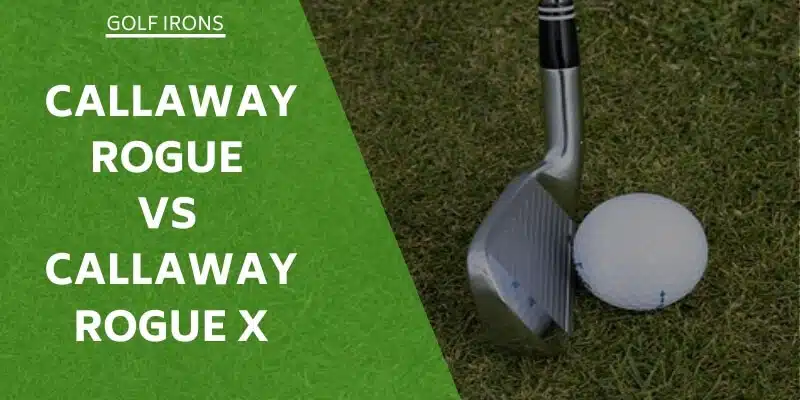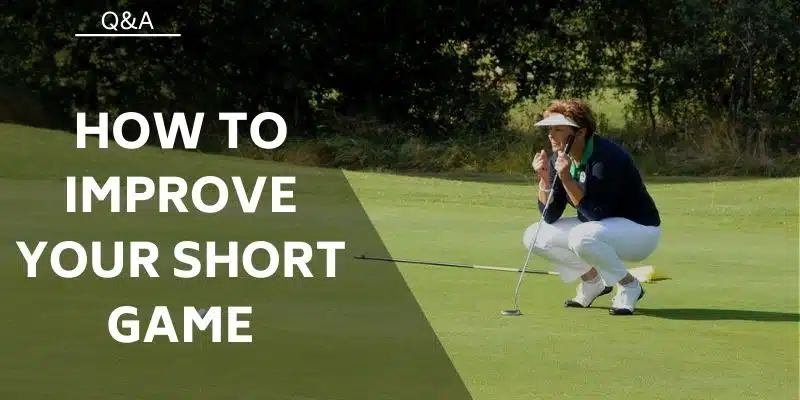Golfers know that mastering the driver swing vs iron swing is essential for consistent and successful play. These two techniques require distinct approaches due to their unique mechanics and objectives.
This article aims to provide a comprehensive guide to understanding and perfecting these vital golf swings.
Exploring their differences and offering improvement tips can elevate your golf game and lower your scores.
Key Differences Between Driver Vs Iron Swing
There isn’t just one difference between your driver and iron swing. Knowing this difference can significantly impact your overall golf performance and help you make the necessary adjustments in your game.
Setup And Posture
- Ball position: The ball position for a driver swing is usually closer to the front foot, whereas, for an iron swing, it is more centered between the feet. This difference in position impacts the angle of attack and trajectory of the shot. Positioning the ball forward in the driver swing promotes a sweeping motion, while a centered ball position in the iron swing encourages a downward strike.
- Stance width: A wider stance is used for the driver swing to create a stable base, allowing for a more powerful swing with increased balance. In contrast, a narrower stance is preferred for iron swings, as it provides more control and precision, essential for approaching the green and navigating various course conditions.
- Spine angle: The spine angle is more upright in a driver swing, promoting a shallower angle of attack and helping to launch the ball higher. The spine is slightly tilted forward in an iron swing, encouraging a steeper attack angle for better ball contact and a more controlled trajectory.
Driver Vs Iron Swing Plane
- Driver swing plane vs iron swing plane: The driver swing has a flatter swing due to the longer club shaft and lower loft, while the iron swing has a steeper angle due to the shorter shaft and higher loft.These differences in swing plane impact the angle of attack and how the clubface interacts with the ball at impact. If you’re unsure which loft to use, we’ve got an article on that right here!
- Club path and angle of attack: The driver swing requires a sweeping motion with a shallow angle of attack, which helps maximize distance and minimize backspin. On the other hand, the iron swing demands a descending blow with a steeper angle, promoting more backspin and control for precise shots on the green.
Tempo And Rhythm— Golf Swing Driver Vs Iron
- Speed and control: The driver swing is typically faster and more aggressive, focusing on generating maximum power and distance off the tee. In contrast, the iron swing requires more control and precision, allowing for better shot shaping and distance management.
- Transition between backswing and downswing: A smooth transition in the driver swing generates consistent ball flight and distance, while the iron swing often features a deliberate, abrupt change of direction to ensure accurate ball contact and trajectory control
Read more: The Best Golf Swing Tips
Driver Swing: Tips And Techniques

The driver swing is essential for launching the ball off the tee and setting up a successful hole. To improve your driver swing, consider the following tips and techniques that focus on the unique aspects of this powerful swing:
Importance Of The Driver Swing
A powerful and accurate driver swing is crucial for setting the tone of each hole. It allows golfers to cover significant distances, helping them reach the green in fewer strokes.
Furthermore, a well-executed driver swing can provide a psychological advantage over your competitors, showcasing your ability to control the ball and shape your shots.
Proper Setup For Driver Swing
- Ball position: Place the ball near your front foot, aligning it with the inside of your front heel. This forward position promotes a sweeping motion and a higher launch angle, maximizing distance off the tee.
- Stance width: Adopt a wider stance for stability, with your feet shoulder-width apart or slightly wider. This stable base enables you to generate more power and maintain balance throughout the swing.
- Spine angle: Keep your spine upright and maintain a slight tilt away from the target. This position helps you achieve a shallower angle of attack and promotes a higher launch for increased distance.
Mastering The Driver Swing Plane
- Club path and angle of attack: Generate a sweeping motion with a shallow angle of attack to maximize distance. This sweeping motion minimizes the potential for excessive backspin, which can rob your shots of valuable yardage.
- Clubface alignment: Ensure that the clubface is square at impact to enhance accuracy. Maintaining proper clubface alignment throughout the swing is crucial for reducing hooks and slices, leading to more consistent drives.
Driver Swing Tempo And Rhythm
- Speed and control: To maximize distance and solidify ball contact, concentrate on harnessing power while keeping control and a steady, balanced movement. Resist the urge to over-swing, as it can lead to imbalance, diminished precision, and erratic ball trajectory.
- Transition between backswing and downswing: For enhanced consistency in ball flight, prioritize a fluid shift from backswing to downswing. This smooth progression fosters superior harmony between your upper and lower body, boosting power and command over the ball.
Additional Driver Swing Tips
- Grip pressure: Maintain a relaxed grip on the club to promote smooth wrist action and enhance clubhead speed. A tight grip can limit wrist hinge and hinder your ability to generate maximum power.
- Tee height: Experiment with various tee heights to find the optimal setup for your driver’s swing. A higher tee can encourage a more upward angle of attack, while a lower tee may help you focus on solid contact and control.
- Visualization: Visualize your intended shot shape and target before addressing the ball. This mental preparation can improve focus and increase the likelihood of a successful shot.
Read more: How To Hit A Driver Consistently
Iron Swing: Tips And Techniques

The iron swing is essential for precision shots and approaching the green. Mastering the iron swing allows golfers to tackle various course conditions and execute a wide range of shots.
To improve your iron swing, consider the following tips and techniques that focus on the unique aspects of this more controlled swing:
Importance Of The Iron Swing
The iron swing is vital in navigating the golf course with precision and control. It allows golfers to shape shots, manage distance, and tackle various course conditions effectively. Furthermore, a well-executed iron swing can distinguish between reaching the green in regulation or struggling to save par, significantly impacting your score.
Proper Setup For Iron Swing
- Ball position: Position the ball more centered between your feet, gradually moving it forward for longer irons. This placement encourages a downward strike on the ball, resulting in cleaner contact and a more controlled trajectory.
- Stance width: Use a slightly narrower stance for better balance and control during the swing. A narrower stance allows for more effortless weight transfer and promotes a more precise swing.
- Spine angle: Maintain a slight forward tilt in your spine to promote a descending blow at impact. This tilt encourages a steeper angle of attack, resulting in better ball contact and a higher, more controlled ball flight.
Mastering The Iron Swing Plane
- Club path and angle of attack: Focus on creating a steeper angle of attack to ensure clean contact with the ball and generate optimal trajectory. A downward strike compresses the ball against the clubface, generating backspin and promoting a more controlled flight.
- Clubface alignment: Pay close attention to clubface alignment throughout the swing to improve accuracy and consistency. Proper alignment reduces the risk of mis-hits and allows for more precise shot shaping and distance control.
Iron Swing Tempo And Rhythm
- Speed and control: Emphasize control and precision rather than power in your iron swing. A controlled swing promotes better contact, trajectory, and distance control, essential for approaching the green and navigating various course conditions.
- Transition between backswing and downswing: Ensure a smooth yet deliberate transition to create consistent ball flight and distance control. A well-timed transition allows better synchronization between your upper and lower body, increasing accuracy and control.
Additional Iron Swing Tips
- Grip pressure: Maintain a relaxed grip on the club to encourage proper wrist hinge and smooth swing mechanics. A firm, but not overly tight, grip allows for better control and feel during the swing.
- Divot analysis: Pay attention to the divots you create during iron shots. Divots can provide valuable feedback on your angle of attack and club path, helping you identify areas for improvement.
- Visualization: Visualize your intended shot shape, trajectory, and target before addressing the ball. This mental preparation can improve focus and increase the likelihood of a successful shot.
Common Mistakes And How To Avoid Them—Iron Swing Vs Driver Swing
Even experienced golfers can make mistakes in their driver and iron swings. Being aware of these common errors can help you make the necessary adjustments and improve your game.
In this section, we will identify some of the typical mistakes golfers make with both their driver and iron swings and provide guidance on how to correct them and fix your swing.
Mistakes With Driver Swing
- Poor ball position: Ensure the ball is positioned near your front foot to optimize launch conditions.
- Incorrect stance: To generate power and maintain balance, it’s essential to maintain a wide and stable stance. A narrow or unstable stance can hinder your ability to achieve maximum distance and negatively impact accuracy.
- Swinging too hard: Focus on a smooth, controlled swing rather than swinging with excessive force, as over-swinging can lead to a loss of balance, reduced accuracy, and inconsistent ball flight.
Mistakes With Iron Swing
- Poor ball position: Position the ball correctly between your feet to improve contact and trajectory for a successful iron swing.
- Incorrect stance: Adopt a slightly narrower stance to enhance control and balance. An overly wide or unstable stance can hinder your ability to make clean contact and control your shots.
- Swinging too hard: Prioritize precision and control over power in your iron swing. Over-swinging can result in mis-hits, inconsistent distance control, and a loss of accuracy.
Addressing Common Mistakes
- Practice with purpose: To correct these common mistakes, dedicate practice time to address specific issues in your swing. Focus on one area at a time and use drills or exercises to reinforce proper technique.
- Seek professional help: Consider working with a golf instructor or coach to identify areas of improvement and receive personalized guidance on how to correct your swing flaws.
- Analyze your swing: Use swing analysis tools, such as video recordings or swing analysis apps, to assess and understand your swing and identify errors in your setup, swing plane, or tempo.
FAQs—Iron Vs Driver Swing
Is The Iron Swing The Same As The Driver Swing?
No, the iron swing and driver swing are distinct in several ways, including setup, swing plane, and tempo. With a flatter swing plane, the driver swing emphasizes power and distance, while the iron swing prioritizes precision and control, featuring a steeper swing plane.
Differences in ball position, stance width, and spine angle also contribute to the contrasting characteristics between these two types of swings.
Is It Harder To Hit Driver Or Iron?
Difficulty in hitting a driver or iron varies among golfers, depending on individual skills and preferences. Some players find it challenging to hit a driver due to its long shaft and lower loft, which demand a powerful and well-timed swing. We strongly recommend learning how to hit a driver consistently for improved skills.
Conversely, others may struggle with iron shots that require accuracy and controlled distance. Regular practice of both swings can help golfers enhance their overall performance.
Conclusion
Recognizing the differences between the driver swing and iron swing is crucial for golfers wanting to elevate their game.
By mastering the unique aspects of setup, swing plane, and tempo for each swing type, golfers can improve their skillset and adapt to various course conditions.
Dedication to practice and continuous learning will lead to significant progress on the golf course.
Clint is PGA-certified and was a Head Teaching Professional at one of Toronto's busiest golf academies. He was also featured on Canada's National Golf TV program, "Score Golf Canada," twice. He graduated with a degree in Golf Management from the College of the Desert in California and studied under Callaway's co-founder, Tony Manzoni.
He has a handicap index of 6.2 and spends the winters near Oaxaca, Mexico, where he plays twice a month at the Club de Golf Vista Hermosa. He's written over 100 articles at GolfSpan since 2021. You can connect with Clint at LinkedIn, FB, his website, or Clintcpga@gmail.com.
- Best score: 68
- Favorite club: Odyssey White Hot Two-Ball Center-Shafted Putter
- Favorite ball: Titleist Pro V1x
- Favorite food at the turn: Hot dog








